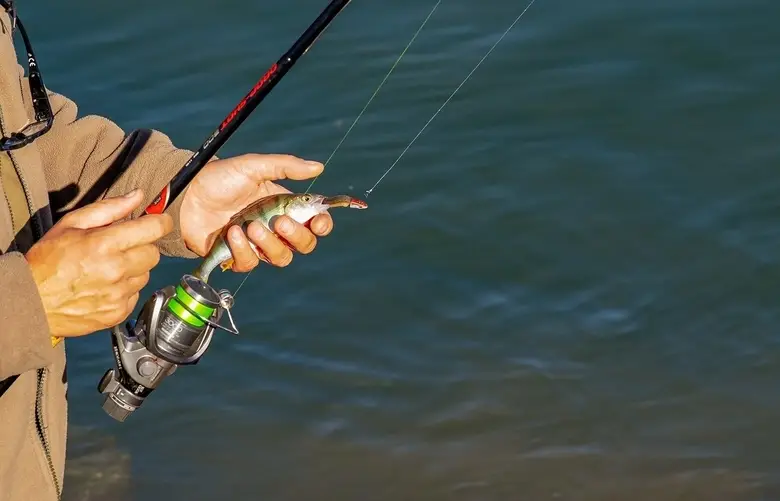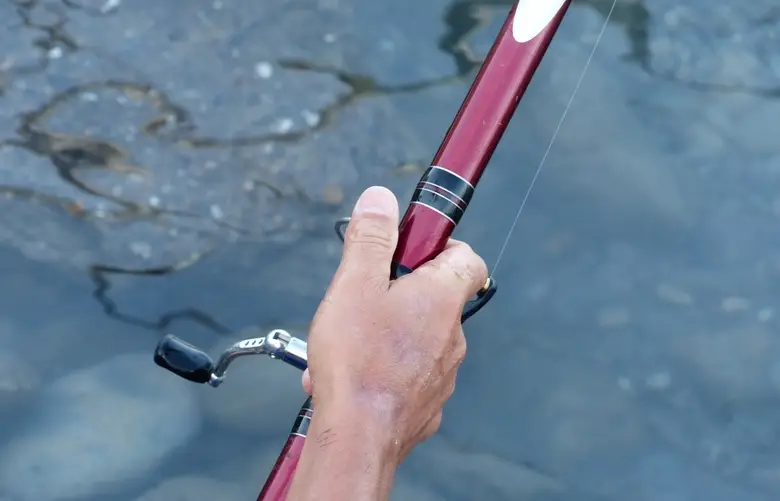Without fishing line, you ain’t fishing. A lot of us take our fishing line for granted, hitting the water session after session, without even considering its condition until the spool starts looking a little empty.
The average weekend angler, who fishes occasionally, can expect the fishing line to last for quite a while before it needs replacing.
However, for those on the water every weekend or more, particularly in hot sunny summers, the fishing line requires your attention and regular monitoring.
When the fishing line is handled too casually, trophy fish are lost. A damaged and worn fishing line loses its strength, and that will cost you fish.
Let’s look at tips for re-spooling a fishing reel and tips for monitoring your fishing line for signs of wear and damage.
Page Contents
Does Fishing Line Go Bad?
If you keep any type of fishing line dust and grime free, then your fishing line will probably outlast you.
While that might be a bit of an exaggeration, I know that I have used some old 20 pound Water Queen mono fishing line my grandfather gave me when I was a kid.
It must have been over 30 years old when I pulled it out.
While I didn’t test in a scientific way, I used it, caught fish, and had no trouble. Many will argue varying storage life for the different line types, from 3 to 12 years and beyond.
I can’t verify any of this, because fishing line is not given a used by date by the manufacturers. Ultimately, it’s about appropriate storage.
Let that be the first tip. When you store your refill spools, store them well out of the sun, in a place where dust, dampness, and other airborne fallout can’t touch them.
While we’re on the early tips, here’s another.
When you’re buying a pre-spooled reel or new spool of fishing line from the tackle shop, avoid any products that have been exposed to direct sun.
Displays in windows and fishing line merchandising units that catch the sun are bad news.
And you will often find combos already spooled with mono that see a little sun when on display. Avoid them, especially mono.
The moment the fishing line, mono, in particular, is exposed to UV rays it begins to degrade.
Both braid and Fluoro have excellent UV resistance, but mono, even UV resistant mono, will suffer over time when exposed to the sun.
With those quick tips under your fishing belt, let’s have a look at things that degrade, wear, damage the fishing line.
Firstly, it’s important to understand that the three types of lines we use, mono, fluoro, and braid, differ in their durability as they are made from different materials and manufactured in different ways.
People have told me that the shelf life of quality mono is 2 to 3 years, fluoro up to 8 years, and braid 12 years or more.
However, nobody, including manufacturers, has been able to give me any hard science about this.
Nor have I been given anything concrete about how line quality, test weight, or diameter impact this equation. So, I refer you back to appropriate storage for indefinite shelf lives of all fishing line types.
Simply store it appropriately, then check it when you’re ready to use it.
How to Tell If Your Fishing Line is Bad?

There are tell-tale signs that warn you it’s time to change your fishing line.
Let’s have a look at them in detail, but first, we’ll look at how you might assess an older unused fishing line that’s still on the spool it came on.
Checking Unused Stored Fishing Line
When stored appropriately, there should be no obvious sign of fishing line degradation.
Check for discoloration by removing a few layers and comparing the color of the top layers with the lower layers. If there is discoloration, simply remove the discolored line.
If it has not been used there will be no fraying, nicks, or cuts. So a drop in strength can only be tested by a break test.
Generally, an elaborate strength test is unnecessary. I test line strength by tying a hook to one end of about 4 feet of line, and a ring to the other.
Then I simply pull it with everything I have, guided by test weight, obviously. If it holds, then happy days.
I will also check if it has remained supple to the touch, and knot tying friendly.
Again, if it feels good, and knots tie well – happy days. This is the case for each line type, however, take extra caution when checking mono.
Checking Used Line
Used line, or the line that’s currently on your reel and has seen a few sessions should be checked at the start of each session.
Not the whole spool, obviously, but the first few layers should be checked.
You’re checking for serious decoloration, nicks, cuts, and fraying. You’re also checking for kinks, which are common in thicker, harder mono, and fluoro.
Fraying
Fraying is caused by friction. When your fishing line rubs against any surface, smooth, or rough, it will fray. Fraying is more severe when the rubbing happens when the line is under load.
It happens during battles when fish drag you against gnarly snags, and it happens with simple casting and retrieving.
Fraying is usually pretty obvious. You can see it. And if you can’t see it, run the line between your fingers and you’ll certainly feel it.
No doubt you will have seen your leader look very frayed following a session fishing the cover, such as chasing reef species or rock fishing.
Any fraying is bad, and a frayed fishing line should be removed. Fraying weakens your line significantly and also exacerbates friction.
Good fluoro has the best resistance to fraying, followed by good mono, with braids having an unpredictable resistance – sometimes it’ll hang on, other times, you’ll lose good fish to frayed braid.
Discoloration
All fishing lines will lose their color when exposed to the elements. Both mono and braid will discolor pretty quickly over a few sessions.
Good fluoro has great UV resistance and holds its color a little longer.
Pull a few layers from your spool. About a casting length. Check the color versus the color of the lower layers of the line. Heavy discoloring is a warning sign – remove it for safety’s sake.
Light discoloration is normal, and may even happen after a few sessions. Check it for suppleness. If it’s still supple, then it’s likely ok.
It’s important to note that many braids will discolor very quickly, however, it IS NOT a sign of a weakened line.
A lot of new braids have great color retention, but some will fade quickly. Fading is far less of a concern in braids, but nonetheless, a consideration.
Fluoro has excellent UV resistance and while it will discolor, it resists the sun’s weakening rays extremely well.
Mildew
I’m pretty slack when it comes to caring for my fishing reels, and in 40 years I’ve not once had mildew on my line (that I recall) and that’s including putting away wet reels in the tropics.
If you’re dealing with mildew, line damage is the least of your worries, I’d be more concerned about your rod and reel.
Mildew is organic, and over time it may damage the fishing line. Wash/wipe your reel down after each session and store dry.
If mildew has just started, wash it off, your line will be OK. If it’s set in and been growing for a while, replace the entire spool with a new line so the mildew does not stay/return.
Nicks/Cuts/Kinks
To check for nicks, cuts, and kinks, simply look at the first few layers of your line to casting length, and run it through your fingers.
Kinks are easy to see, they weaken line, and inhibit casting performance. It’s pretty common in harder monos and fluoros.
Nicks and Cuts can be obvious, particularly in mono and fluoro. They’re easy to check for by running the line through your fingers.
Both mono and fluoro can handle nicks and cuts to a certain extent, however, they do cause significant weakness, requiring removal of the affected line.
Braid performance suffers terribly from nicks and cuts. It doesn’t take much of a nick, and your braid is certain to fail.
Again, look and feel the line to casting length, and remove any line with nicks or cuts.
When Should You Respool a Spinning Reel?
You should respool a spinning reel every couple of months if you’re a weekly angler fishing surf, rocks, reef, and cover of any type.
Otherwise, I have NO replacement time standard. Replace line based on the advice listed above. Check it out. It’s a waste to throw out a perfectly good line based on a time schedule.
Replace the line that’s damaged, kinked, frayed, twisted, discolored older line, nicked, or cut.

If it’s old, has plenty of knots from adding extra line, and seen a few fish battles, and fights with snags, replace it for safety.
But check it. Don’t throw away the line because you think it’s too old. It may well be fine. I respool when it looks like it needs it.
I will generally need to replace a full spool of line due to taking off damaged line over many sessions.
A good tip is to remove a full spool of an older line, then re-spool it, putting the old line on the arbor.
The line that never saw the sun is now the top layer, and working to catch you fish. It’s a great line-saving practice.
Just make sure the line that’s been compressed many layers down, isn’t kinked or out of shape.
How Often Should You Change Monofilament Fishing Line?
Check your monofilament fishing line at the start of every session. Mono is prone to sun damage and stretching.
Again, don’t use time as an indicator, check it first.
The older it is, the more thorough you should check. On principle, I’ll pull off a quarter-cast length every few sessions when fishing heavy cover.
How Often Should You Change Fluorocarbon Fishing Line?
Same as for mono, but keep in mind your fluoro will handle the UVs, stretch, and abrasions better than most mono.
It will last longer. Don’t let that lull you into a false sense of security, however. Check it out. No time limit. Just check!
How Often Should you Change Braided Fishing Line?
Braid is expensive, but it can last a very long time, making it cost-effective in the long run.
If my braid has been in contact with structure, cover, gnarly snags, and the like, I’ll replace 10 or 20 feet of it every couple of sessions.
Eventually, with this type of fishing, it’s not long before a re-spool.
However, I have some big reels with the same braid I put on it 5 years ago, probably longer, and it’s great!
Again, check it. Don’t throw away good fishing line just because somebody told you about some random shelf life.
When Should You Respool a Baitcasting Reel?
It doesn’t matter what type of reel you have, most of the wear on fishing line comes via guides, in the water, and under the sun.
Everything mentioned above applies to all reel types.
Check your line before you rig at the start of each session. You’ll save more line, and you won’t lose fish to worn fishing line.
Sharing is caring!
